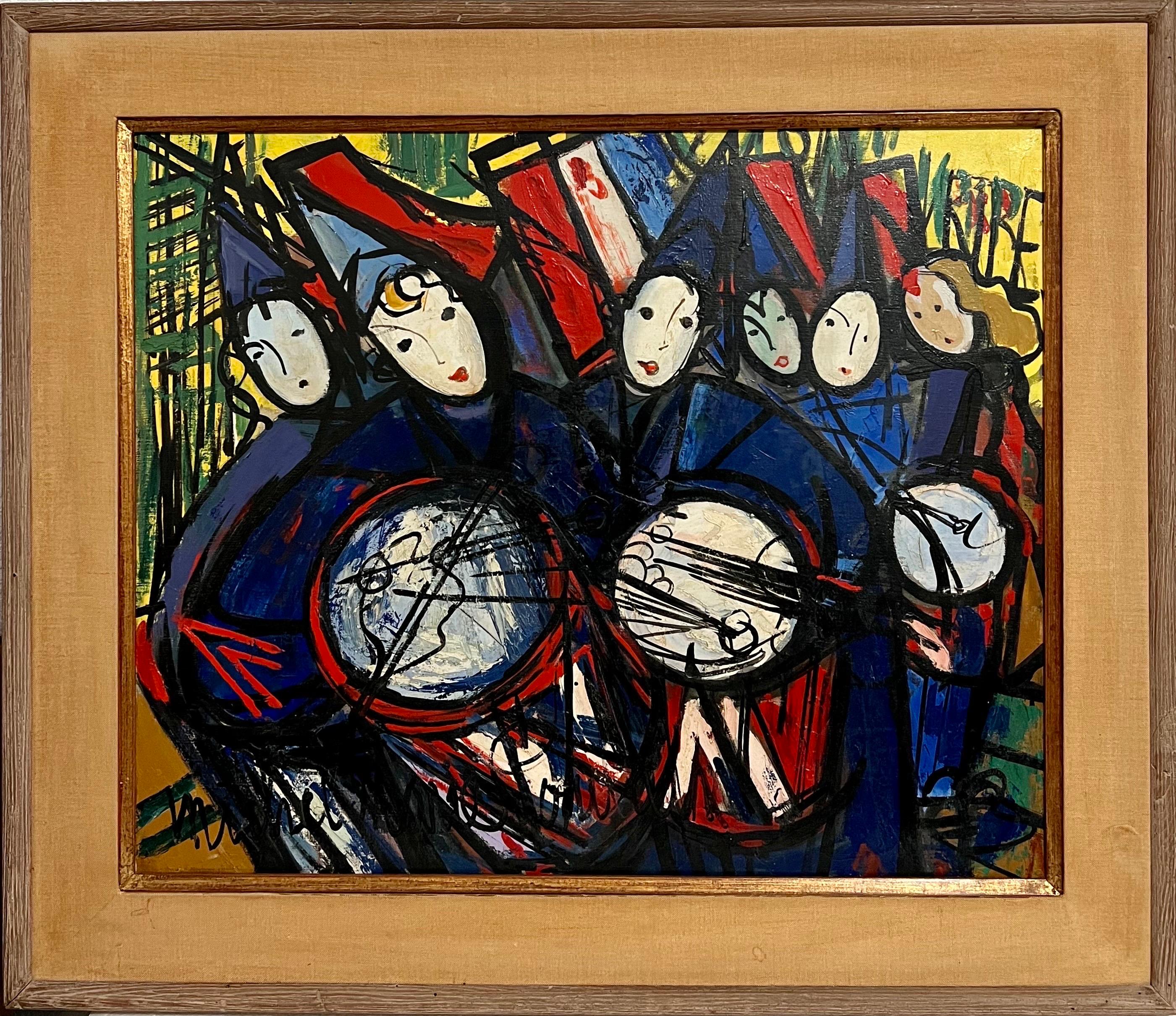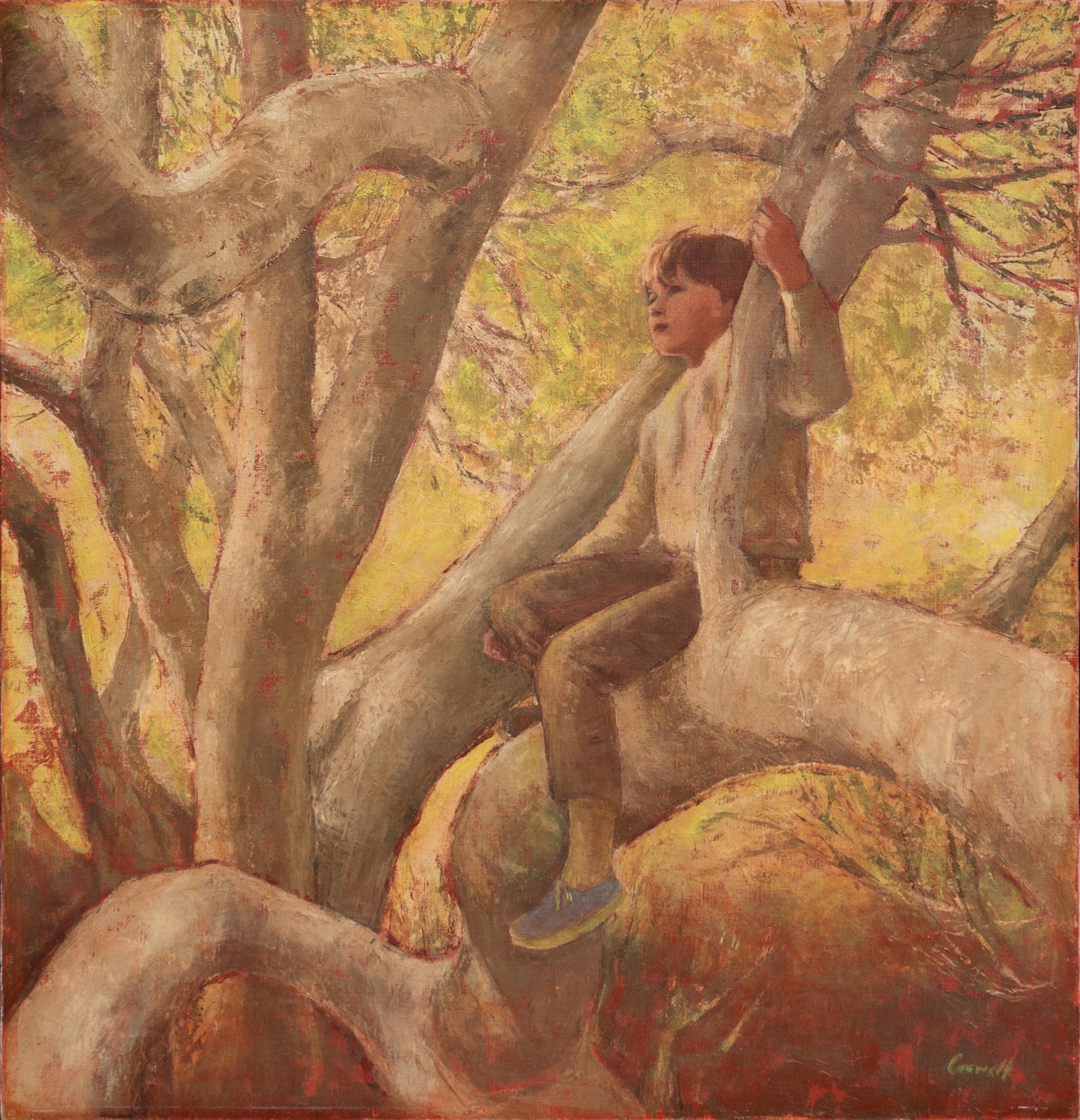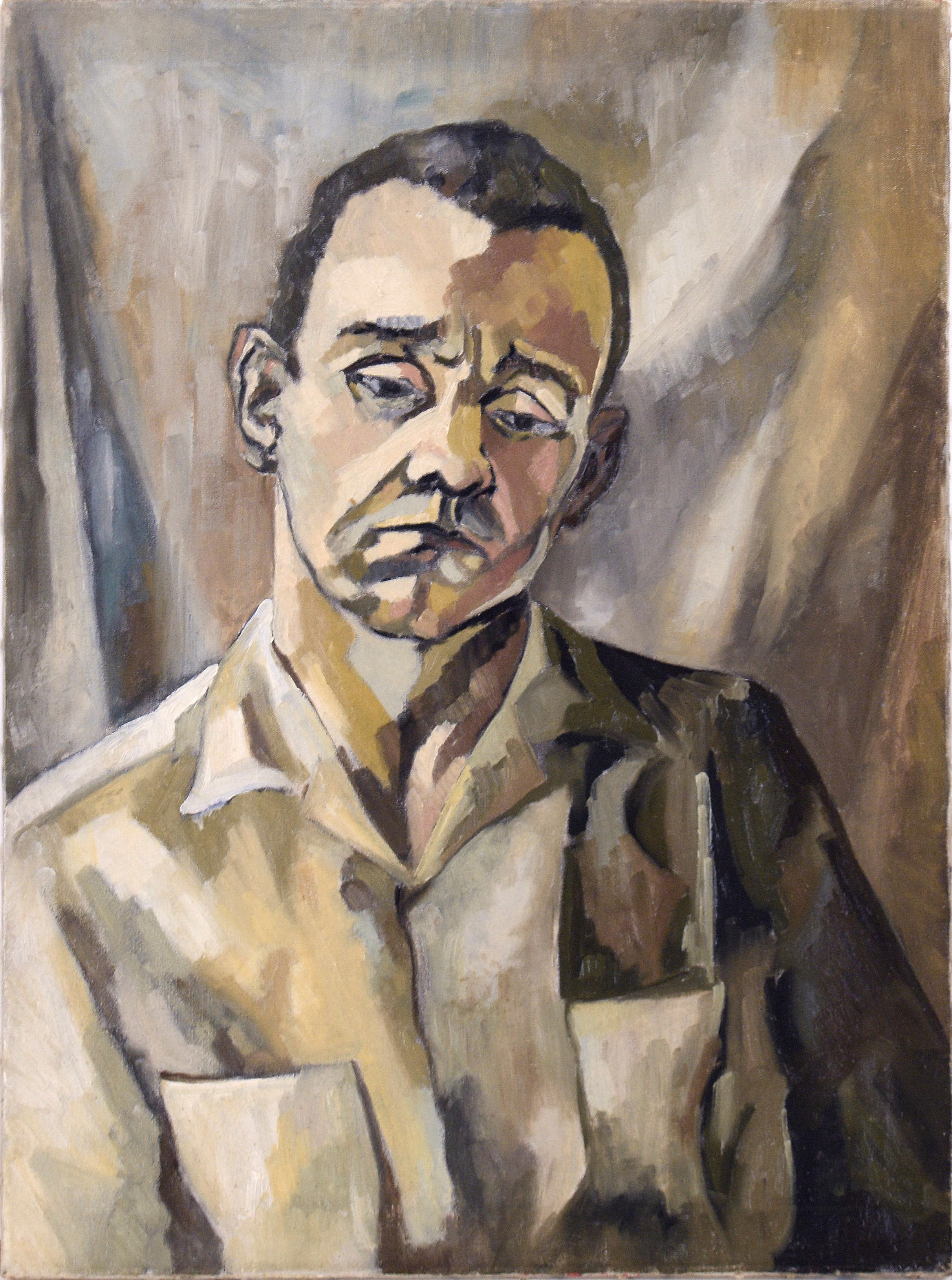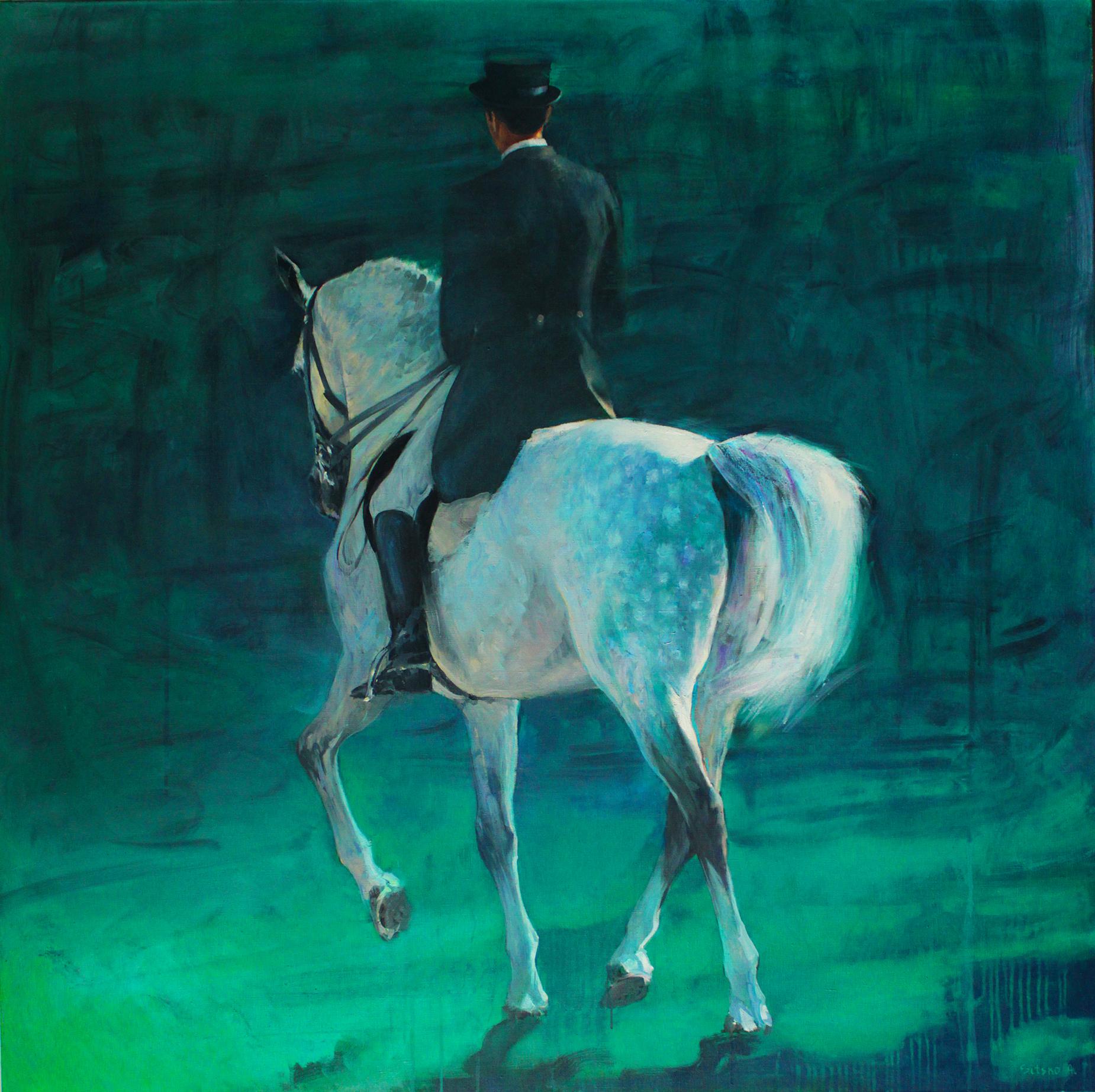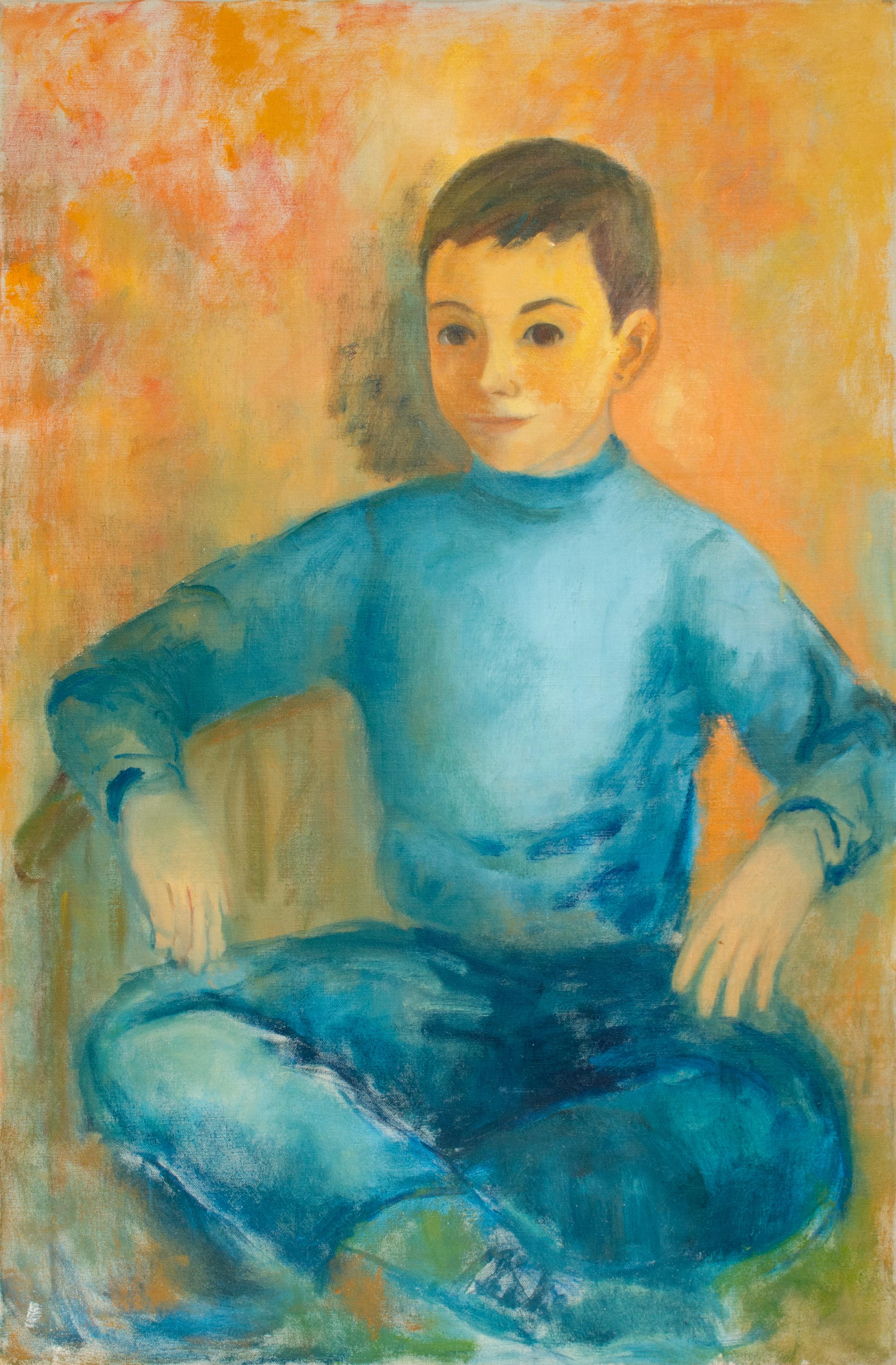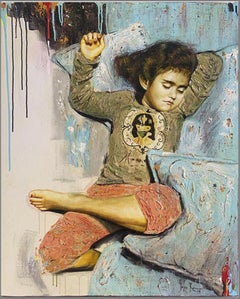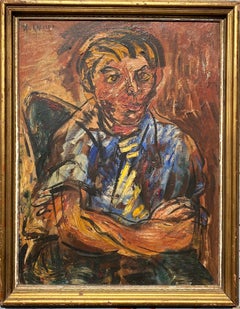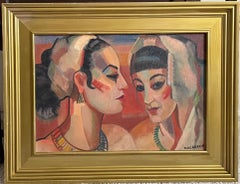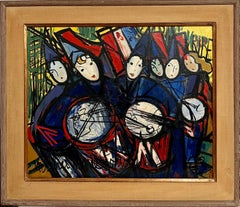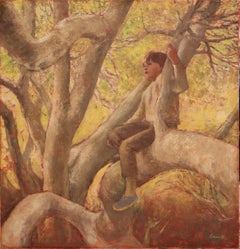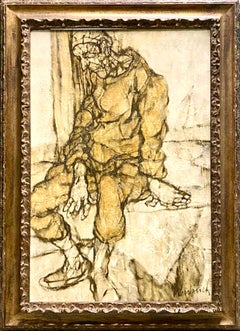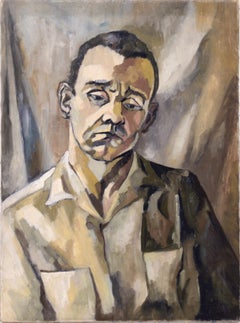Items Similar to LADY WITH PICK FAN
Want more images or videos?
Request additional images or videos from the seller
1 of 6
MAX TURNERLADY WITH PICK FAN1990
1990
About the Item
Biography from the niece of the artist from during his lifetime. Paintings acquired from the artist.s estate.
Max Turner
1925 - 2019
Max Lamar Turner Painter, Sculptor, Teacher and Author.
Max Turner was born in Omaha, Nebraska on July 28, 1925. His father was Lance Howard Turner and his mother Mary Irene Turner. In 1927, his family moved to Bingham Canyon, Utah where Max's father extracted copper from a creek that he had diverted to pass through his garage. The town was located in a narrow canyon on the eastern face of the Oquirrh Mountains. In 1938, when Max was 13, his family moved to Midvale, Utah. After completing high school, Max went to work laying rail until he was inducted into the U.S. Navy to serve during W.W. II.
There he took an aptitude test and was initially assigned to the medical corp., later transferring to the dental unit. Max was stationed at Port Hueneme, Ventura County, California through the end of the war. When he was discharged in 1946, he remained in Southern California, living in the Los Angeles area. He met a man named Larry Torres and they formed a partnership to do silk screen work primarily for the Colby Poster Printing Company. This lasted about 10 years until the Colby building caught fire and burned down. In 1958, Max began working for Slade Novelty company that made doll parts using a product called plastisol. A year later, Max began producing plastic parts through his own business. One day, a couple of kids brought in a shrunken skull they had made and asked Max if he could reproduce it. Max said he could and he looked around for a business to work with for this task. He ultimately decided he could create his own machine shop to make molds. As a result, Max purchased a lathe, drill press, grinder and other tools to create his own machine shop and went into business making molds. He built a clientele and in 1973, he moved his machine shop to Glendale, California.
Painter, Sculptor, Teacher and Author:
Max recalls the day when his interest in art took a new direction. He happened to be in a paint store to purchase some supplies when he saw a card posted on a wall that read, "Come paint with Connie Marlo". Max had been interested in art since his youth and he was frequently impressed with paintings displayed by local artists at various community events.
Consequently, he decided to go to Connie's Saturday morning art class at a studio on North La Brea Avenue (between Sunset and Hollywood) in Los Angeles. But, as fate would have it, he immediately took a detour from this class when he found a piece of paper on the floor of the studio referencing another art class dealing with compositions, patterns, rhythms and color harmony. The instructor's name was Hal Reed, a former art student of the Russian/American Master, Nicolai Fechin. Hal owned the building (previously the Will Foster Studio) and had founded the Art League of Los Angeles. When Max found Hal, he asked Hal if he could join his class. Hal said "No, the class was full" but he said Max could monitor the class in the back of the classroom. Max took him up on the offer and began observing the weekly class.
During the class, Hal told his students that they should practice what they were learning by going to "live model" classes. Max began attending these classes where he learned how to draw figures. After a few months, Hal and Max became good friends. Hal was so impressed with Max's work that he offered Max the opportunity to teach at another location that Hal was opening in the San Fernando Valley. Max accepted the offer and began teaching his own art class. For Max, it was a quick jump from learning to teaching. Max then found that several of his students had to commute to his art class from the west end of the "Valley". To better serve this group of students, Max decided to relocate to another studio in Calabasas.
Max continued teaching, and at this time he was producing very impressive portraits, both oil paintings and charcoal drawings from live models (Max never worked from photos). Max demonstrated real talent, and the style of his drawings and paintings were being compared to those of Nicolai Fechin. And, like Fechin, Max also had an interest in sculpting. One day, Max decided to design and cast a bronze owl sculpture to put in his Calabasas Fine Art Gallery. Later, someone approached Max when he was at the foundry and asked him about his success selling the owl sculpture. The individual who asked this question was convinced that there was a broader market for these sculptures and he ordered a dozen of the owl sculptures from Max. This encouraged Max to do more castings. Some of the new castings were antique sculptures he found and reproduced. As this new business grew, he decided to establish his own foundry, employing up to 15 workers. The business continued for many years, up until the late 1990's when Max got tired of the foundry business and sold it.
Max, who was now in his 70's, decided to move on to his next venture as an artist, dedicating himself to doing the actual sculpting of original art. He loved the creativity of sculpting and he had his sculptures cast at local foundries, ironically the same ones that used to be his competition. Max was now fully engaged in his new artistic direction and, over time, he produced a large body of work. He created very impressive sculptures, including about 100 full-size sculptures. He sold some of these to high-end clientele, the Foundry at SLS Las Vegas, and to Hollywood studios.
Even though Max now seemed to be totally in his element, he somehow also found time to continue to teach painting classes at the California Art Institute in Westlake Village in Los Angeles. At the institute, he specialized in figure work. Max continued to draw, paint and teach, but he says he stopped sculpting when he turned 90.
Max produced four books showcasing his drawings and paintings. The first is "Faces, The Drawings of Max Turner", copyright 2000, that showcases nearly 100 of his portrait drawings. Within the "Acknowledgements" section, he lists Hal Reed and Joseph Nordmann, two former students of Nicolai Fechin.
In 2006, Max produced his second book titled "Figures and Faces", reflecting not only portraits but also figure drawings and paintings. It is a wonderful book of Max's work, but it is currently difficult to find. The third book is titled "Faces 2, The Paintings and Drawings of Max Turner", copyright 2009, which includes 75 portrait paintings and drawings. In the "Preface" of this book, Max describes growing up in a small and isolated mining town during the Great Depression. He states that as a kid, he had little exposure of any culture or view of what the rest of the world was like. His neighbor was the trash collector and Max would sometimes go through his truck looking for anything of value. Among other things, he found magazines like Cosmopolitan, Good Housekeeping and Red Book, with covers that frequently showed drawings or paintings of faces. Max states that these images were the very first source of inspiration for him. He says that he began looking more carefully at people's faces and if they had character, he would draw them. By drawing them, Max says that he was making them part of his world, his world of "Faces".
In 2018, Max published his newest book showcasing his drawings and paintings. It is titled "Max Turner's Figure Sketches". This softbound book includes 76 pages and over 120 drawings and paintings. In the Introduction, Max explains "I have found that when approaching the figure, one should begin with the gesture. After having captured the essence or feeling of the pose, one can then proceed to build on it." The figure sketches in this wonderful book reflect a Master's work that consistently captures the "gesture"-showing the emotion, movement and expression.
Two more books are on the horizon for Max, both dealing with his passion for sculpting. His first, "The Sculpture of Max Turner" is a compilation of his commercial and noncommercial pieces throughout his career. The second, "Terra Cotta Sculpture by Max Turner" is a complete collection of figures done at the California Art Institute. These much anticipated books should be out later in 2018.
Max now considers himself primarily a sculptor. But others in the art world are more than impressed with his drawings and paintings as well. His portraits are often described as having a Fechin-esque appearance, referring to the style of Nicolai Fechin. When Max observed those first art classes given by Hal Reed, it should be noted that Hal had previously been a student of the Russian/American Master Nicolai Fechin in the early to mid-1950's. In fact, Hal was a student in the last art class that Fechin taught before he unexpectedly died in 1955. Hal was so strongly influenced by Fechin that he later produced two 30-minute art instruction videos as part his Art Video Productions wherein he specifically described Fechin techniques that he learned in Fechin's class. The Fechin style and techniques were in play when Max later met Hal. Over the years, many of Max's art students, art collectors, gallery owners, as well as the Director of the Monterey Museum of Art have commented on the Fechin-esque qualities of Max's wonderful charcoal drawings and paintings. So, while Max may consider himself primarily a sculptor, his drawings and paintings are also impressive and very much sought after.
When Nicolai Fechin died in 1955, three of the nine students in his last art class became life-long friends. Max subsequently became friends with not only Hal Reed, but also with prior Fechin students Joseph Nordmann and Albert Londraville. These four professional artists all state that they were strongly influenced by this Russian/American Master and each demonstrated this influence in their art.
The Fechin influence on Max Turner's drawings and paintings can be seen by watching the on-line video "The Art of Max Turner" and comparing the style to the art slides in the video "Nicolai Fechin: A Collection of 320 Paintings".
Some of the other past artists that have influenced Max include Frank Brangwyn, Sergei Bongart, Mariano Fortuny, Abram Arkipov, Antonio Mancini, and sculptor Stanisav Szukalski. Among present day artists Max appreciates the work of Richard Schmid, Dan Mc Caw, Peter Liashkov, and Jeremy Lipking.
Memberships and Institutes
California Art Club, Member
California Art Institute, Instructor
Art League of Los Angeles (founded by Hal Reed), Instructor
References :
.
About the Seller
5.0
Vetted Professional Seller
Every seller passes strict standards for authenticity and reliability
Established in 1972
1stDibs seller since 2011
403 sales on 1stDibs
Typical response time: <1 hour
- ShippingRetrieving quote...Shipping from: Los Angeles, CA
- Return Policy
Authenticity Guarantee
In the unlikely event there’s an issue with an item’s authenticity, contact us within 1 year for a full refund. DetailsMoney-Back Guarantee
If your item is not as described, is damaged in transit, or does not arrive, contact us within 7 days for a full refund. Details24-Hour Cancellation
You have a 24-hour grace period in which to reconsider your purchase, with no questions asked.Vetted Professional Sellers
Our world-class sellers must adhere to strict standards for service and quality, maintaining the integrity of our listings.Price-Match Guarantee
If you find that a seller listed the same item for a lower price elsewhere, we’ll match it.Trusted Global Delivery
Our best-in-class carrier network provides specialized shipping options worldwide, including custom delivery.More From This Seller
View AllBLONDE WITH ART DECO NECKLACE
Located in Los Angeles, CA
Biography from the niece of the artist from during his lifetime. Paintings acquired from the artist.s estate.
Max Turner
1925 - 2019
Max Lamar Turner Painter, Sculptor, Teacher and Author.
Max Turner was born in Omaha, Nebraska on July 28, 1925. His father was Lance Howard Turner and his mother Mary Irene Turner. In 1927, his family moved to Bingham Canyon, Utah where Max's father extracted copper from a creek that he had diverted to pass through his garage. The town was located in a narrow canyon on the eastern face of the Oquirrh Mountains. In 1938, when Max was 13, his family moved to Midvale, Utah. After completing high school, Max went to work laying rail until he was inducted into the U.S. Navy to serve during W.W. II.
There he took an aptitude test and was initially assigned to the medical corp., later transferring to the dental unit. Max was stationed at Port Hueneme, Ventura County, California through the end of the war. When he was discharged in 1946, he remained in Southern California, living in the Los Angeles area. He met a man named Larry Torres and they formed a partnership to do silk screen work primarily for the Colby Poster Printing Company. This lasted about 10 years until the Colby building caught fire and burned down. In 1958, Max began working for Slade Novelty company that made doll parts using a product called plastisol. A year later, Max began producing plastic parts through his own business. One day, a couple of kids brought in a shrunken skull they had made and asked Max if he could reproduce it. Max said he could and he looked around for a business to work with for this task. He ultimately decided he could create his own machine shop to make molds. As a result, Max purchased a lathe, drill press, grinder and other tools to create his own machine shop and went into business making molds. He built a clientele and in 1973, he moved his machine shop to Glendale, California.
Painter, Sculptor, Teacher and Author:
Max recalls the day when his interest in art took a new direction. He happened to be in a paint store to purchase some supplies when he saw a card posted on a wall that read, "Come paint with Connie Marlo". Max had been interested in art since his youth and he was frequently impressed with paintings displayed by local artists at various community events.
Consequently, he decided to go to Connie's Saturday morning art class at a studio on North La Brea Avenue (between Sunset and Hollywood) in Los Angeles. But, as fate would have it, he immediately took a detour from this class when he found a piece of paper on the floor of the studio referencing another art class dealing with compositions, patterns, rhythms and color harmony. The instructor's name was Hal Reed, a former art student of the Russian/American Master, Nicolai Fechin. Hal owned the building (previously the Will Foster Studio) and had founded the Art League of Los Angeles. When Max found Hal, he asked Hal if he could join his class. Hal said "No, the class was full" but he said Max could monitor the class in the back of the classroom. Max took him up on the offer and began observing the weekly class.
During the class, Hal told his students that they should practice what they were learning by going to "live model" classes. Max began attending these classes where he learned how to draw figures. After a few months, Hal and Max became good friends. Hal was so impressed with Max's work that he offered Max the opportunity to teach at another location that Hal was opening in the San Fernando Valley. Max accepted the offer and began teaching his own art class. For Max, it was a quick jump from learning to teaching. Max then found that several of his students had to commute to his art class from the west end of the "Valley". To better serve this group of students, Max decided to relocate to another studio in Calabasas.
Max continued teaching, and at this time he was producing very impressive portraits, both oil paintings and charcoal drawings from live models (Max never worked from photos). Max demonstrated real talent, and the style of his drawings and paintings were being compared to those of Nicolai Fechin. And, like Fechin, Max also had an interest in sculpting. One day, Max decided to design and cast a bronze owl sculpture to put in his Calabasas Fine Art Gallery. Later, someone approached Max when he was at the foundry and asked him about his success selling the owl sculpture. The individual who asked this question was convinced that there was a broader market for these sculptures and he ordered a dozen of the owl sculptures from Max. This encouraged Max to do more castings. Some of the new castings were antique sculptures he found and reproduced. As this new business grew, he decided to establish his own foundry, employing up to 15 workers. The business continued for many years, up until the late 1990's when Max got tired of the foundry business and sold it.
Max, who was now in his 70's, decided to move on to his next venture as an artist, dedicating himself to doing the actual sculpting of original art. He loved the creativity of sculpting and he had his sculptures cast at local foundries, ironically the same ones that used to be his competition. Max was now fully engaged in his new artistic direction and, over time, he produced a large body of work. He created very impressive sculptures, including about 100 full-size sculptures. He sold some of these to high-end clientele, the Foundry at SLS Las Vegas, and to Hollywood studios.
Even though Max now seemed to be totally in his element, he somehow also found time to continue to teach painting classes at the California Art Institute in Westlake Village in Los Angeles. At the institute, he specialized in figure work. Max continued to draw, paint and teach, but he says he stopped sculpting when he turned 90.
Max produced four books showcasing his drawings and paintings. The first is "Faces, The Drawings of Max Turner", copyright 2000, that showcases nearly 100 of his portrait drawings. Within the "Acknowledgements" section, he lists Hal Reed and Joseph Nordmann, two former students of Nicolai Fechin.
In 2006, Max produced his second book titled "Figures and Faces", reflecting not only portraits but also figure drawings and paintings. It is a wonderful book of Max's work, but it is currently difficult to find. The third book is titled "Faces 2, The Paintings and Drawings of Max Turner", copyright 2009, which includes 75 portrait paintings and drawings. In the "Preface" of this book, Max describes growing up in a small and isolated mining town during the Great Depression. He states that as a kid, he had little exposure of any culture or view of what the rest of the world was like. His neighbor was the trash collector and Max would sometimes go through his truck looking for anything of value. Among other things, he found magazines like Cosmopolitan, Good Housekeeping and Red Book, with covers that frequently showed drawings or paintings of faces. Max states that these images were the very first source of inspiration for him. He says that he began looking more carefully at people's faces and if they had character, he would draw them. By drawing them, Max says that he was making them part of his world, his world of "Faces".
In 2018, Max published his newest book showcasing his drawings and paintings. It is titled "Max Turner's Figure Sketches". This softbound book includes 76 pages and over 120 drawings and paintings. In the Introduction, Max explains "I have found that when approaching the figure, one should begin with the gesture. After having captured the essence or feeling of the pose, one can then proceed to build on it." The figure sketches in this wonderful book reflect a Master's work that consistently captures the "gesture"-showing the emotion, movement and expression.
Two more books are on the horizon for Max, both dealing with his passion for sculpting. His first, "The Sculpture of Max Turner" is a compilation of his commercial and noncommercial pieces throughout his career. The second, "Terra Cotta Sculpture by Max Turner" is a complete collection of figures done at the California Art Institute. These much anticipated books should be out later in 2018.
Max now considers himself primarily a sculptor. But others in the art world are more than impressed with his drawings and paintings as well. His portraits are often described as having a Fechin-esque appearance, referring to the style of Nicolai Fechin. When Max observed those first art classes given by Hal Reed, it should be noted that Hal had previously been a student of the Russian/American Master Nicolai Fechin in the early to mid-1950's. In fact, Hal was a student in the last art class that Fechin taught before he unexpectedly died in 1955. Hal was so strongly influenced by Fechin that he later produced two 30-minute art instruction videos as part his Art Video Productions wherein he specifically described Fechin techniques that he learned in Fechin's class. The Fechin style and techniques were in play when Max later met Hal. Over the years, many of Max's art students, art collectors, gallery owners, as well as the Director of the Monterey Museum of Art have commented on the Fechin-esque qualities of Max's wonderful charcoal drawings and paintings. So, while Max may consider himself primarily a sculptor, his drawings and paintings are also impressive and very much sought after.
When Nicolai Fechin died in 1955, three of the nine students in his last art class became life-long friends. Max subsequently became friends with not only Hal Reed, but also with prior Fechin students Joseph Nordmann and Albert Londraville...
Category
1990s Modern Figurative Paintings
Materials
Oil, Canvas
$650 Sale Price
48% Off
SUENO PROFUNDO
By Sofia Ruiz
Located in Los Angeles, CA
SUENO PROFUNDO
OIL AND ACRILIC ON CANVAS
SIGNED, 2013
EXHIBITED MUSEO DEL BANCO CENTRAL
DE COSTA RICA
43.25 X 35.5 INCHES
Sofía Ruiz was born in 1982....
Category
2010s Surrealist Figurative Paintings
Materials
Oil, Canvas, Acrylic
Man with Yellow Tie
Located in Los Angeles, CA
ALEXANDER KREISEL
"MAN WITH YELLOW TIE"
OIL ON CANVAS BOARD, SIGNED
RUSSIAN-AMERICAN, C.1935
26 X 19.5 INCHES
FRAMED 29.5 X 23.5 INCHES
Alexander Krei...
Category
1930s Expressionist Figurative Paintings
Materials
Canvas, Oil
$1,688 Sale Price
24% Off
Alexandria
By Buckley MacGurrin
Located in Los Angeles, CA
BUCKLEY MACGURRIN
"ALEXANDRIA"
OIL ON CANVAS, SIGNED, TITLED
AMERICAN, DATED 1949
EXHIBITED: DALZELL-HATFIELD GALLERY
14 X 20 INCHES
Buckley MacGurrin
1896 –1971
Buckley MacG...
Category
1940s Art Deco Figurative Paintings
Materials
Canvas, Oil
MEJOR SOLAS
By Sofia Ruiz
Located in Los Angeles, CA
"MEJOR SOLAS"
OIL AND ACRILIC ON CANVAS
SIGNED AND DATED 2010
EXHIBITED MUSEO DEL BANCO CENTRAL
DE COSTA RICA
47.5 X 59 INCHES
Sofía Ruiz was born in ...
Category
2010s Surrealist Figurative Paintings
Materials
Canvas, Oil, Acrylic
UNTITLED
By Sofia Ruiz
Located in Los Angeles, CA
"UNTITLED"
OIL AND ACRILIC ON CANVAS
SIGNED
35.5 X 27.5 INCHES
Sofía Ruiz was born in 1982.
What she expresses through her paintings has to do with whe...
Category
2010s Surrealist Figurative Paintings
Materials
Oil, Canvas, Acrylic
$6,500
You May Also Like
Large Colorful French Mid Century Oil Painting Michel Marie Poulan Marching Band
Located in Surfside, FL
Michel Marie Poulain (1906-1991)
French Musicians.
Oil on canvas. Signed lower left.
Provenance: Greenwich, CT estate.
Dimensions: 21" h x 25.5...
Category
Mid-20th Century Modern Figurative Paintings
Materials
Canvas, Oil
'In the Sycamore', Large Figural Oil, Carmel, California Woman Artist, Muralist
By Helen Rayburn Caswell
Located in Santa Cruz, CA
Signed lower right, 'Caswell' for Helen Rayburn Caswell (American, 1923-2018) and painted circa 1955.
A substantial, mid-century figural oil by this listed California woman artist who showed her talent at an early age. In Saratoga, Caswell began a successful career as an artist and portrait painter, displaying in galleries in Carmel and teaching artist workshops. In addition to her work as a fine artist and portrait painter, Helen wrote and illustrated over 30 books for children and adults. In 1981, Helen moved to Occidental in Sonoma County where, in addition to continuing to paint and teach, she designed stained glass windows for the Sebastopol United Methodist Church. She was also commissioned to paint numerous murals including at St. Ignatius Church in San Francisco and for the Elizabeth Seton Center in Menlo Park.
Category
1950s Modern Portrait Paintings
Materials
Canvas, Oil
Large French Figurative Expressionist Oil Painting Seated Figure Claude Weisbuch
By Claude Weisbuch
Located in Surfside, FL
WEISBUCH, Claude.
Oil on Canvas
Framed size: 39” H x 28” W
Canvas, without frame: 32” high x 21 ¼” wide.
Carved wooden frame with antique gold-leaf finish
Claude Weisbuch, 1927-2014 French painter, draftsman and engraver. He studied at the Ecole des Beaux-Arts (School of Fine Arts) in Nancy and upon graduation became a professor of engraving at the Ecole des Beaux-Arts de of St. Etienne. His first solo exhibition was in 1957.
In 1968 , he became a full member of the Society of French Painters-Engravers .
In 1997 he was awarded the Legion of Honor
His work is essentially devoted to engraving, by which he likes to translate, thanks to the line, the life, movement and character of his characters: Punchinels, harlequins, musicians or equestrian scenes. He practices various techniques ( lithography, drypoint etching etc.) that he puts to use in the illustration of bibliophile books.
Claude Weisbuch is also a painter and draftsman. His favorite colors are ochres, browns and whites, with which he seeks to introduce the effects of light by compositions where the line and finesse of the drawing preserve the life found in his engravings.
His precise and dynamic line delivers a moving and swirling work on themes he loves: theater, opera, equestrian, musicians, card players, Kabuki dancers and many portraits.
His works have the appearance of unfinished sketches mixing few colors but a great vivacity of the line. He illustrated many limited edition signed fine art books. Alon with Christo, Arman and Cesar he is considered among the great post war French artists of the last generation.
Exhibitions
1957: Saint Placide Gallery, paintings and engravings
1958: Galerie de Presbourg, Paris, paintings - Saint Placide Gallery, Paris, paintings - Galerie des Arts, Nancy, etchings
1960: Galerie Hervé, "Extraordinary Pantomimes", Paris, paintings
1961: Salon of the young painting and painters witnesses of their time
1962: O'Hanna Gallery, London , paintings
1963: Galerie Hervé, "Portrait Of Man", Paris, Paintings - Nichido Gallery, Tokyo, Paintings
1965: Hervé Gallery, "100 Drawings", Paris Dresdener Gallery, Toronto, paintings
1966: Dantesca Gallery, Turin , paintings, engravings, drawings
1968: New Vision Gallery, Paris, engravings
1969: Galerie Hervé, Paris, paintings - Galerie Reflets, Brussels , prints, paintings - Galerie Dresder, Montreal , paintings
1970: Taménaga Gallery, Tokyo, paintings - Sagot Gallery - The Garrec, Paris, etchings - Museum of Modern Art of the City of Paris ARC, Paris, prints 5
1971: War Gallery, Avignon , etchings Biennial of Engraving, Epinal
1972: Dantesca Gallery, Turin Festival, Sarlat , paintings
1973: Wayss Gallery, Nancy , paintings, engravings, drawings Auguste Comte Gallery, Lyon , paintings, engravings, drawings Taménaga Gallery, Tokyo, paintings - New Vision Gallery, "Homage to Rembrandt", Paris, etchings
1974: Esthetika Gallery, Kortrijk, engravings - Galerie Hervé Odermatt, Paris, paintings Ésthetika Gallery, Kurne, prints - Galerie Wayss, Nancy, engravings, drawings, pastels Dietesheim Gallery, Neuchâtel , engravings - Grafikhuset Gallery, Stockholm , prints, drawings
1975: Schwarzer Gallery, Vienna , engravings, paintings, drawings Fogola Gallery, Turin, drawings, pastels Sotheby-Parke Benett, Munich, engravings, drawings Hervé Odermatt Gallery, Paris, drawings Joly Gallery, Washington , engraving
1976: Taménaga Gallery, Tokyo, paintings - Wayss Gallery, Nancy, engravings, drawings - Tabula Gallery, Tübingen, engravings, drawings - New Vision Gallery, "The horse-The painter and his model", Paris, drawings, engravings
1977: Grafikhuset, Futura, Stockholm - Jivô Gallery, Vänersborg Pigalle Gallery, Norrköping Celsius Gallery, Uppsala Möbius Gallery, Gothenburg - New Vision Gallery, Jerusalem - Cultural Center of Sainte-Menehould Castle, retrospective, engravings
1978: David Barnett Gallery, Milwaukee , engravings, drawings Orangery Gallery, Cologne , engravings, drawings, pastels Grafikhuset Futura, Stockholm, paintings, drawings Les Cordeliers, Châteauroux, engravings, drawings, paintings House of Culture, Montbéliard, engravings House of Culture, Chelles , engravings, paintings, drawings
1979: L'Empreinte Gallery, Strasbourg, prints, drawings - Galerie Reflets, Brussels, prints, drawings - Galerie Bon à tirer, Los Angeles , prints, pastels
1980: Hervé Odermatt Gallery, Paris, "Calligraphy of the figure", paintings - E. Gollon Gallery, Saint-Paul-de-Vence
1981: European Biennale of Engraving, Baden-Bade Galerie The Art Shop, Nice Galerie Hélène Trintignant, Montpellier Martine Remy Gallery, Strasbourg
1982: Vallen Gallery, Stockholm - Sagot Gallery - The Garrec, Paris - Taménaga Gallery, Tokyo, paintings - New Vision Gallery, Tokyo, Nagoya, Osaka, etchings
1983: Hélène Trintignant Gallery, Montpellier
1984: Perrine Museum, Laval , etchings - Music Festival, Quimper , etchings Etchings, Moscow - Presence Gallery, Brussels, paintings, etchings
1985: Galerie Moyon-Avenard, Nantes, paintings - Taménaga Gallery, Paris, paintings - New Otani Hotel, Ōsaka, realization of murals
1986: Taménaga Gallery, Tokyo, paintings - Greenhouse of the School of Fine Arts, Saint-Étienne , paintings, engravings
1988: Retrospective paintings, Château de Chenonceau Retrospective engravings, Artothèque Museum Montpellier Taménaga Gallery, Paris, drawings, pastels New Vision Gallery, Tokyo, engravings
1989: Galerie Taménaga, Paris, paintings
Exit of the book Weisbuch , texts of Jean-Denis Bredin of the French Academy, preface by Jean-Marie Tasset.
1990: Taménaga Gallery, Paris, paintings
1992: Retrospective, Sarlat - Taménaga Gallery, Paris, drawings
1993: Taménaga Gallery, Tokyo and Osaka
1994: Paintings for the second international meetings of the cello ensemble, Beauvais - Elegance Gallery, Taipei - Sanbi Gallery, Tokyo, graphic works - Mitsukoshi, Tōkyō
1995: Taménaga Gallery, Ōsaka - Exhibition of the Gobelins Municipal Circle, Paris 13 th
1996: 2nd Music Trades Fair, Premonstratensian Abbey , Pont-à-Mousson , paintings - Ginza Spring, Tokyo, paintings - New Otani Museum, Tokyo, paintings
1997: Galerie Raugraff, Nancy, paintings, pastels, drawings, engravings, lithographs - Theater Gallery, Besançon, paintings, drawings, engravings, lithographs
1999: A retrospective "Weisbuch, 50 years of prints", 230 works exhibited in Strasbourg under the direction of its publisher, L'Estampe Éditions 3 - Taménaga Gallery, Paris, Tōkyō
2000: Retrospective Château de Vascœuil , by L'Estampe - Theater Gallery, Besançon , paintings, drawings, engravings, pastels, lithographs - Retrospective Chamber of Commerce, Strasbourg - engravings (retrospective), Jacques Brel cultural center, Thionville - engravings (retrospective ), chamber of commerce, Nancy
2001: Retrospective Orangerie of Madame Élisabeth, Versailles , paintings
2002: Taménaga Gallery "Movements", Paris
2003: L'Estampe Gallery, in partnership with the Theater Gallery - prints and paintings, Besançon
2004: Taménaga Gallery "Prometheus presenting the secret of fire to humans", Paris Crid'Art Gallery, L'Estampe Gallery, Amnéville-les-Thermes , paintings, prints, drawings, prints - Galerie des Arts, Nîmes , paintings
2010: Galerie125, Argancy , recent works, exhibition of 100 recent works by the artist.
2012: Exhibition at the Château de Malbrouck . More than 150 works by the artist. Organized by the General Council of Moselle and L'Estampe (editor Claude Weisbuch).
2012: Print, Strasbourg, paintings, engravings, drawings
2012: Exhibition at the House of wines of Graves de Podensac in Gironde. 150 works by the artist Event organized by Course N ° 3.
2013: Galerie125, Argancy, "Weisbuch, major works", exhibition of drawings, engravings, lithographs and oils on canvas
2014: Galerie125, Argancy, "Weisbuch, from 1947 to 1960", exhibition of 100 ancient engravings...
Category
20th Century Modern Figurative Paintings
Materials
Canvas, Oil
Mid-Century Modern Man - Portrait in Oil on Canvas
Located in Soquel, CA
Subtle and moody portrait of a Pensive man by Joan Tidwell (American, 1930-2002). The sitter in the portrait is a middle-aged man looking slightly downwards, wearing a collared shirt. This piece is completed in a tan and green palette, creating a somber feeling. Of particular note are the confident, thick brushstrokes - each one is well-placed in the modernist style. Similar in some ways to Picasso's portraits.
Signed "Joan Tidwell" on verso
Unframed.
Canvas size: 30"H x 22"W
oan Gay Tidwell (American, 1930-2002) was born and raised in Hollywood, CA, where she had some success as a child actor. Later, she graduated Magna Cum Laude from the University of Washington with a Master's Degree in English Literature and Drama. Tidwell moved to the Bay...
Category
1960s American Modern Portrait Paintings
Materials
Canvas, Oil
$2,000 Sale Price
20% Off
Emerald Shine Original Oil Painting with Hourse by Andrei Sitsko
Located in Zofingen, AG
This painting is dedicated to courage, strength, and beauty. Man and horse, interaction, love. Powerful and restrained color.
• Linen canvas, high-quality oil paints.
• Two coats of protective gloss varnish were applied to protect the painting from UV rays and dust.
• Signed and dated by the artist on the back.
• Includes a certificate of authenticity signed by the artist.
• Shipping rolled in a tube.
Please do not hesitate to contact me!
Thank you for visiting my art!
Best regards!
Andrei Sitsko
Category
2010s Modern Figurative Paintings
Materials
Canvas, Oil
Modernist Portrait of a Child by NY Artist Syril Frank
Located in New York, NY
Syril Frank (American, 1929-2021)
Untitled, c. 1960s
Oil on canvas
35 7/8 x 23 3/4 x 3/4 in.
Provenance: Estate of the Artist
Syril Harriet Frank was born in Brooklyn to Israel and...
Category
1960s Modern Figurative Paintings
Materials
Canvas, Oil
Recently Viewed
View AllMore Ways To Browse
Modern Fan
Vintage 70s Poster Art Posters
Antique Painting Lady
Vintage Art Supplies
Lady Dior Vintage
Lady Dior Canvas
Retro Wall Fan
Trash Can Modern
Painted Wall Unit
Vintage Little Lady
Dior Large Lady Dior
Small Bronze Lady
Bronze Figure Of A Lady
Lady Dior Gray
Painted Dolls Face
Terra Cotta Paintings
Watch With Red Face
Max Turner
